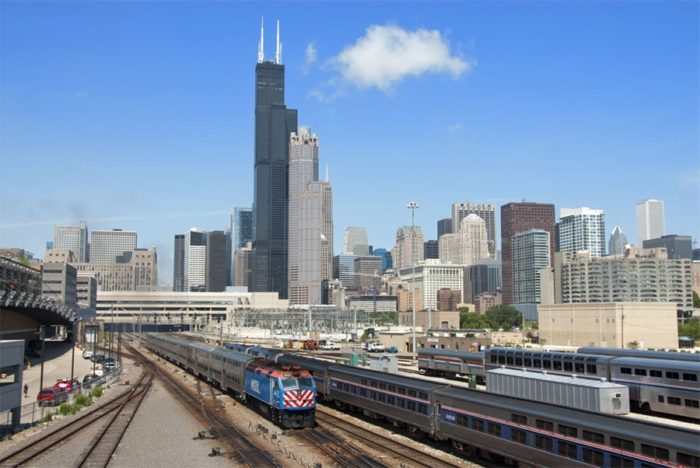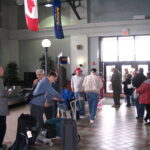The Focus Has Always Been Chicago.
It seems as though I’m always passing through Chicago. That’s not a bad thing, of course. I really like Chicago and it’s a chance to visit old and very good friends living in the city’s suburbs. Chicago is home to major league sports teams; it has a great aquarium; and at the Museum of Science and Industry, you can go inside a captured German submarine, the U-505.
Chicago has been our country’s major rail terminus for probably 150 years and its size and complexity and capacity is, for example, what made Mr. Sears and Mr. Roebuck decide to headquarter their catalogue business there. Trains leaving Chicago multiple times every day could carry items ordered from the Sears catalog to customers all over the country.

Chicago is still the heart of passenger rail in America. It’s “home port” for most of Amtrak’s long-distance trains—nine of them originate in Chicago. It would be nice if there were more, of course, but those nine trains fan out from Chicago and cover a good deal of the country. There are regional trains with Chicago as a terminus, too—trains extending into Michigan and to parts of southern Illinois. The track between Chicago and St. Louis is being upgraded and those trains will soon be running at 110 miles an hour. And trains are already running at 110 along stretches of routes linking Chicago with cities in Michigan.
High speed rail is wonderful, as anyone who has traveled by train almost everywhere else in the world will attest. But the next logical step for the Amtrak network outside of the Northeast Corridor is to increase speeds on existing short-haul routes from a maximum of 79 mph up to 110. Shorter running times always attracts more riders.
(In the U.S., to the everlasting confusion of the general populace, high speed trains travel much faster than highER speed trains. In ascending order, slow to fast, the terminology is 1-conventional … 2-higher speed … and 3-high speed.)
We’re making progress with passenger rail in this country and most of it affects trains coming and going from Chicago. That progress comes in modest increments and only after major effort by advocacy organizations like NARP, civic leaders and private individuals. But one of these days, we’ll look around and see that the Cardinal is a daily train, the Vermonter’s route extends to Montreal, and the City of New Orleans is a two-night trip linking Chicago and Orlando. And even some Republican congressmen will have come around. If constituents back home have spent a few million tax dollars to restore and renovate their railway station, they don’t want to hear that their representative in Congress is not supporting Amtrak.
Frederick Douglas was right. He said, “If there is no struggle, there is no progress.”




One Caveat: The 110 service in Michigan is on right-of-way OWNED by Amtrak or MDOT (Michigan DOT). CSX has a “Just say NO!” policy to speeds above 79MP/h. So, for example, establishing 110 service between Grand Rapids/Lansing/Detroit requires PURCHASING the right-of-way [and it is the ONLY right-of-way] so the cost balloons. This is often a principle obstacle to higher speeds.
The British have been running diesel trains at 125 mph for forty years, and those rakes are capable of 140. Heck, the E units of the Transition Era were good for 117. Might there be a way to modify the track and signalling regulations to permit operation of diesel trains at 140 mph? At the margin, the extra investment in catenary and the rest of the bullet train technology buys only a few minutes faster running time.
That’s a question for one of our NARP directors who is far more knowledgable than I. Let’s see what he says.
It’s the regulation put in place that from 80 mph, you need some safety system for trains and tracks. Technically, you could push the current trains to higher speeds, but regulations forbid it, as does the cost for installing PTC. However, if UI understand correctly, PTC or something like it has to be installed on all railways carrying passengers and hazardous loads, so perhaps in a couple of years you might be running at higher speeds again. Tracks have to allow for it, though.
That is correct. It’s my understanding that Amtrak’s long-distance diesel locomotives can run at a maximum speed of 125 mph, but PTC, or an equivalent system, is required before a train can operate at 80 mph or more . . . hence Amtrak’s top speed along almost all of their long-distance routes is 79 mph.
Exactly. There are stipulations about the track structure plus requirements for signalling and grade crossing protection. With block signals, 79 mph since sometime in the 1950s. With cab signalling, used to be good for 90 or 100. To get to 110, continuous positive train control and four-point grade crossing protection. Those speed intervals oughta be negotiable. Steam trains topping 100 on jointed rail and protected by semaphore signals in the late 1930s … are all the regulations of today necessary?
In spite of some accidents lately, train safety has improved dramatically since the Thirties, too. And improved regulations and signalling have something to do with that.
So I don’t think loosening up regulations is the answer, installing more PTC or something like it on more routes is, and while it is an extra cost for the mainly freight carrying railroads, it’s also beneficial for them.